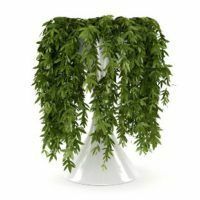
Climbing plants are successfully used for decorating houses and offices. The beauty of them is that they have excellent decorative properties, occupy a large space, which makes it possible to successfully green the premises. Plants that are curly, can be ornamental-deciduous or blooming.
- decorative foliage
- creeping ficus
- Ivy
- Chlorophytum
- Tradescantia
- Philodendron
- Tseropegiya Wood
- Ragwort Rowley
- tsissus
- decorative flowering
- Azarina
- Begonia hang-downing
- bougainvillea
- Kobe
- Gloriosa
- Jasmine
- Passionflower
- stephanotis
- Hoya
- Ipomea
- Campanula
- TUNBERGIA
Ornamental deciduous
This species includes those plants that do not bloom or have inconspicuous flowers, notbearing decorative value. The choice of these plants is wide enough, there are very interesting and unusual varieties.
to contents ^Creeping ficus
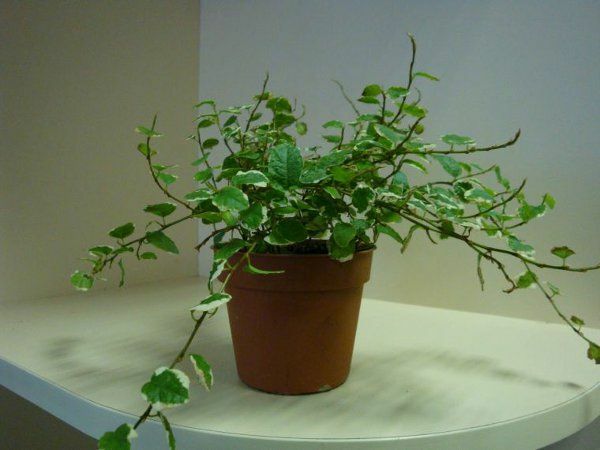
Has graceful shoots, growing rapidly. Its leaves are bright green, heart-shaped. A mesh pattern is visible on the surface of the leaf blade. To cope with the departure is simple, the only thing that is required is a high humidity of air, under such conditions it will retain its decorativeness for a long time.
- Moist air.
- Enough light.
- Reproduction and transplantation in the spring.
- For the formation of the crown - pruning and prischipka.
Ficus can be used as an ampel plant, it is suitable for decorating walls, florariums and flower hills.
to contents ^Ivy
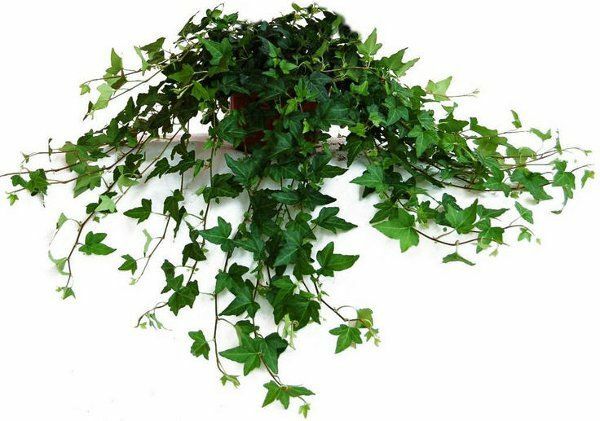
An unpretentious plant that feels good even in dry air. Decorates walls and windows, it is used to mask bare areas, as it gives a thick growth. Leaves of ivy are shiny, leathery. There are variegated varieties, but they are more finicky in care. Refers to curly shade-loving houseplants. Ivy is a little poisonous, therefore, children and animals should not be admitted to it.
- Abundant and timely watering.
- Trimming autumn shoots by 1/3 length, which stimulates branching and density.
- Fertilizing fertilizer 2 times a month.
Chlorophytum
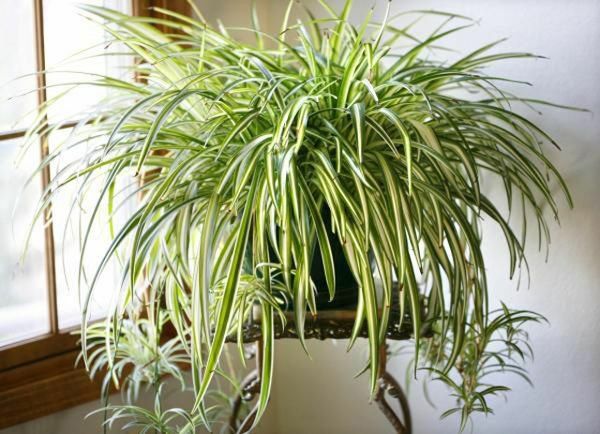
Has long light green leaves and downward shoots, at the ends of which young plants develop. There are mottled specimens with white or yellow longitudinal strips. In care is unpretentious, loves light rooms. Positioning is better on a stand or pots on the wall.
- Timely watering and spraying.
- Feeding every 2 weeks.
- A bright place.
Tradescantia
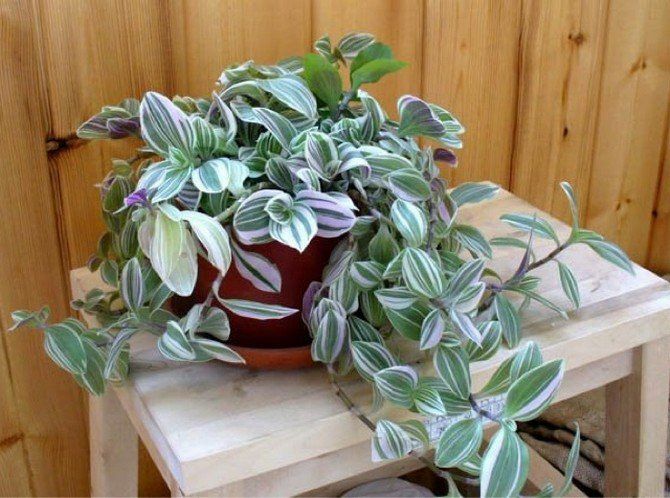
Plant with thin shoots and oblong leaves. There are several varieties with plain sheets and with longitudinal white or yellow stripes. It grows quickly. The flowers are plain, so only leaves are decorative. Variegated varieties are more photophilous.
- Timely copious watering( in winter less than in summer), spraying.
- Top dressing with universal fertilizer.
- If a plant loses its appearance, it is updated by planting several cuttings in one pot.
- For splendor, you can pinch the tops.
Philodendron
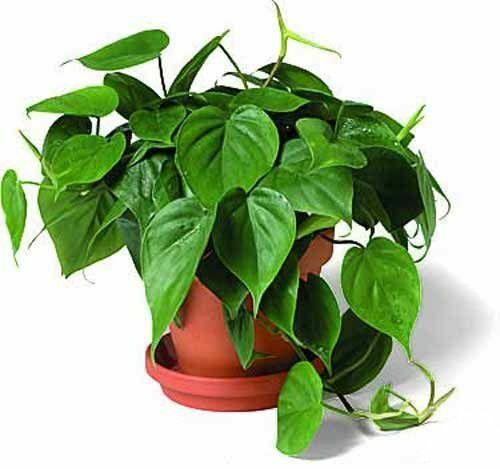
Has heart-shaped dark green shiny leaves 10 cm long. Creeper shoots. To philodendron groom, pinch the tops. Sometimes confused with sketchupsusom. For a better growth and decorative appearance, the plant is tied to supports and directed along the wall. Philodendron is suitable for beginners florists. Refers to shade-resistant climbing houseplants, so it can grow in not very bright rooms.
- Normal watering, do not allow a strong drying of the earth, but in the winter you should be careful.
- For the best growth in the summer, apply universal fertilizers or for decorative-deciduous specimens.
Wood healing wood
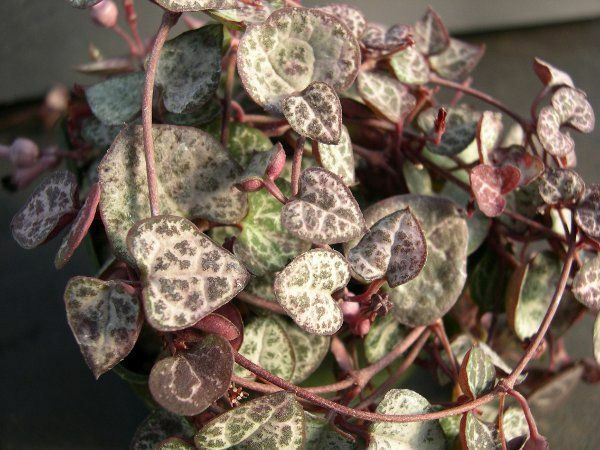
This is an interesting plant with round mottled leaves. The stems are long and thin, in the axils of the leaves, nodules are formed, where the moisture reserve is contained. Stems beautifully intertwined with each other, trying to untangle them should not - they can break. To obtain the density, it is better to plant several shoots of ceropeia in one pot.
- For it, a lack of moisture is better than an excess, since the plant belongs to succulents.
- Preferred bright room with bright sunlight.
- It is better to use hanging flowerpots, so that the branches beautifully fall down and do not break.
- It grows well on the frame, with the help of it you can make different shapes.
Rowley's worm

This plant belongs to succulents and has an unusual appearance. It has creeping shoots, and the leaves resemble pellets up to 1 cm in diameter. It is a suitable plant for hanging flower pots. To increase the decorativeness, a variety with white spots on the leaves was introduced. With room contents, the growth of the shamrock will not exceed 1 meter.
- Needs bright, but diffuse lighting.
- In summer, water is abundant, but you can not fill the plant, otherwise the roots will rot.
- Propagate by shoots, preferably in the warm season.
- Pruning is not done, but sometimes you can pinch the tops, so that the plant is better branched.
Cissus
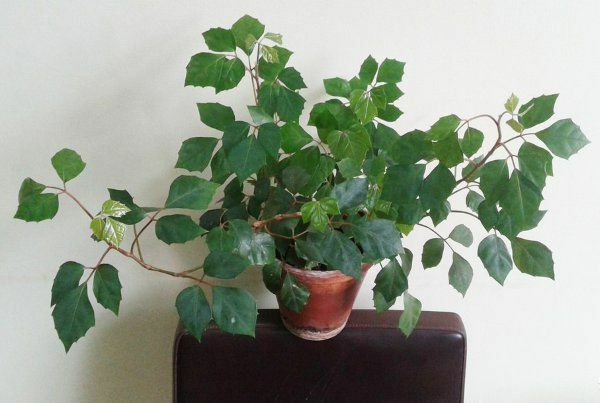
The plant has a second name - "room birch".Curly shoots have green leaves that resemble birch leaves. On the shoots there are curled tendrils, by means of which the cissus clings to the support. Great for home, office or children's rooms. The cissus grows well in the pots and on the supports, creating a green wall. Refers to unpretentious climbing houseplants.
- Regular and abundant watering.
- You can form a small bush if you trim the tip.
- Periodically you need to spray, and even better - to wash under a warm shower.
- Lighting is required to be diffused, in the bright sun the foliage fades.
Decorative-flowering
Decorative curly houseplants are also blooming, that for their suitable for decoration of premises.
to the table of contents ^Azarina

Originally this plant belongs to the garden, but it is successfully grown at home. It has several varieties with bright tubular pink or purple flowers of different shades. It grows on supports. Refers to one-year-old specimens, but with proper care can live in the house up to two years.
- Good lighting and a warm place is required.
- For intensive growth put a support in the form of a lattice, this design will also emphasize the beauty of the plant.
- It loves moisture, it takes a lot of watering in arid times.
- Basically, asarin is propagated by seeds, but propagation by cuttings is also available, for which they are planted in moist sand or perlite.
Begonia ampeled
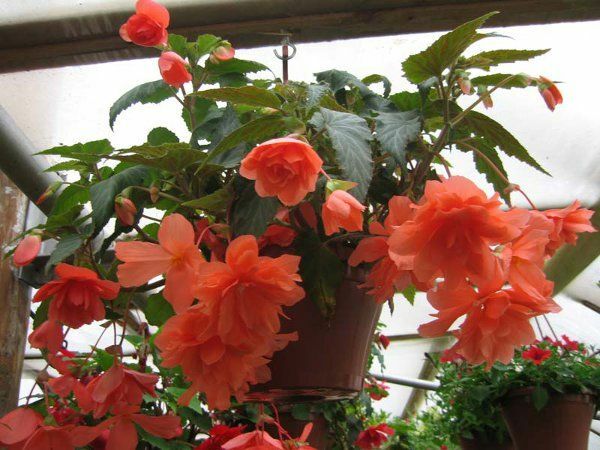
There are many varieties with simple and double flowers of white, yellow, red, pink flowers. Begonia looks spectacular in suspended flowerpots. Blossoms the entire summer season until the fall, which makes it a suitable plant for decorating rooms, balconies and verandas.
- Requires a bright location, but the sun's rays should not be straight, but scattered.
- Watering evenly. Drought or excessive moisture are harmful.
- Heat-loving, the temperature should not fall below 15 degrees.
Bougainvillea
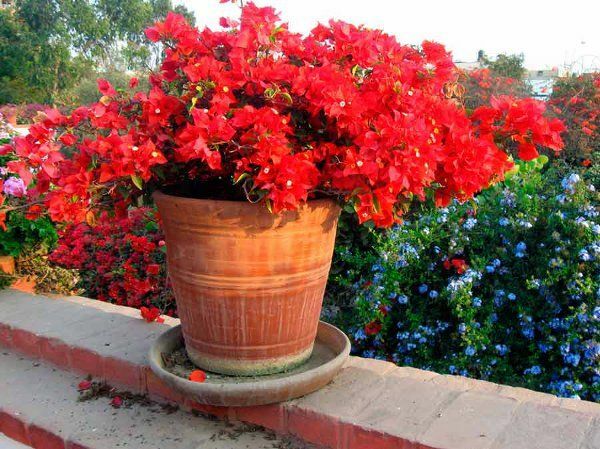
An unusual plant with branches covered with spines. Decorative elements are bright bracts of pink, yellow, purple, red hues, the flowers themselves are yellow. The leaves are ovate to 12 cm, many varieties are pubescent, the plate is dense.
- Thermophilic, requires a temperature above 22 degrees. Well tolerates the heat. During the rest period, the temperature should be maintained at about 16 degrees.
- For good flowering in summer, the maximum amount of light is required. In winter, can tolerate shading.
- Likes humidity, so it should be sprayed.
- Propagate by cuttings 12-15 cm, the cut is treated with a rooting agent and immersed in two internodes into a light primer.
- For the formation use pruning.
Kobeja
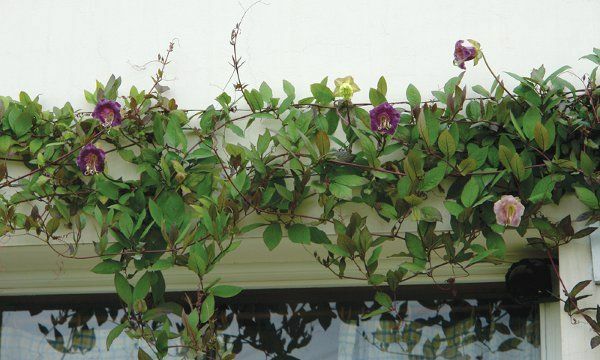
Used for landscaping the garden, but it grows well at home. It is an openwork liana with surprisingly beautiful bell-shaped flowers. To the support it is attached with antennae, so you should install a grate. When grown on the balcony you get a beautiful and colorful flowering wall.
- Cultivated from seeds and tubers.
- For a period of rest, the tubers are cleaned in a cool dry place.
- Constant attention is required: pruning, top dressing and timely watering so that the plant retains its decorative appearance for as long as possible.
Gloriosa

The plant looks like an orchid. The leaves are lanceolate, shoots can reach 5 meters, but there are also dwarf forms. Two-color flowers of the original form, located on long peduncles. Opened bud looks like a flame. There are varieties with yellow, orange, red flowers. To give a beautiful appearance, it is grown on figured supports.
- Preferred moderate temperature in summer, in winter about 10 degrees.
- Likes moderate lighting, it's better to put it on western or eastern windows.
- It originates from the tropics, therefore it likes high humidity, which can be provided by spraying and installing the pot in wet pebbles or expanded clay.
- Propagated by tubers, a seed method is possible, but it is more labor-intensive.
Jasmine
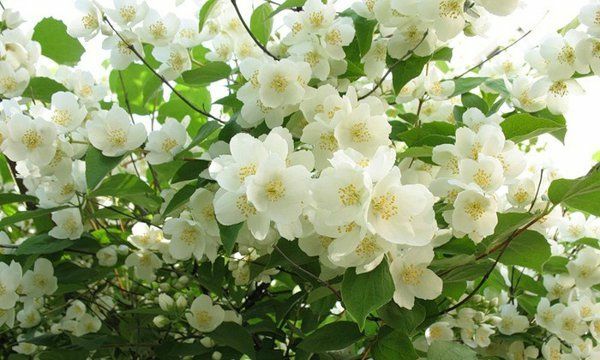
Plant with flexible shoots and dark green leathery leaves. It is popular for growing a house and on verandas. The flowers are white, fragrant, blossom in the middle of winter, and flowering continues until the end of March. It grows up to 2 meters.
- Likes light, can grow on the south side of the house. However, at noon it is better to shade a light curtain or blinds.
- Flowering occurs if during the formation of buds the ambient air temperature is within 15 degrees.
- Requires abundant watering, the soil does not tolerate drying, this leads to falling of leaves.
Passiflora
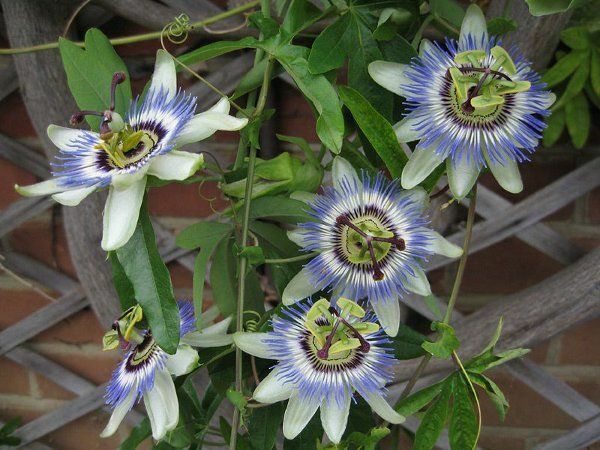
Evergreen vine with very beautiful and unusual colors of different shades. A special feature of the flower is the cross-shaped stigma. At home, three-lane and blue varieties are most often grown.
- You need a bright light, the most suitable place is the southern window.
- Humidity of air passiflora needs increased.
- So that the liana does not occupy the whole space, in the spring it is cut off.
Stefanotis
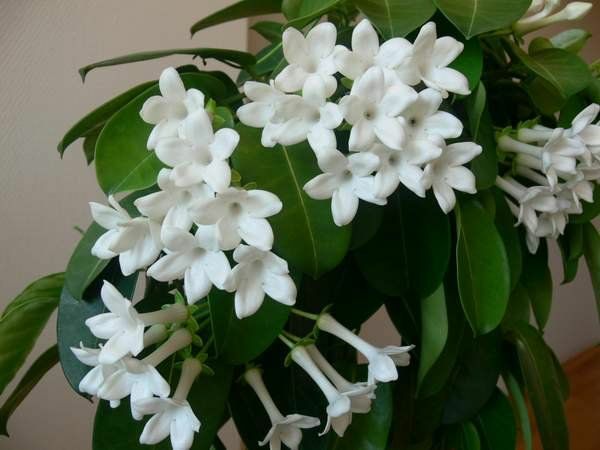
A plant with oval leathery dark green leaves. Flowers funnel-shaped, white, cream, lilac, located on the inflorescence. Fit, it takes a lot of effort to make a beautiful copy of it.
- Loves bright lighting, but at noon it's better to shade.
- The temperature of the content in summer is not higher than 25 degrees, in winter - about 15 degrees.
- Watered with standing water.
- In winter, high humidity is required.
Hoya
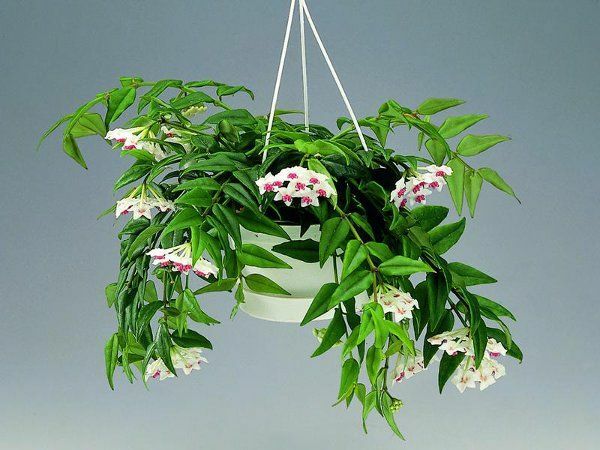
This is an interesting climbing plant with waxy leaves. Flowers have a star-shaped shape, are located on a spherical inflorescence.
- During flowering, you can not move it to another location.
- The best windows are western and eastern.
- The summer requires abundant watering.
- Mandatory fertilizing with phosphorus fertilizer in the summer.
Ipomea
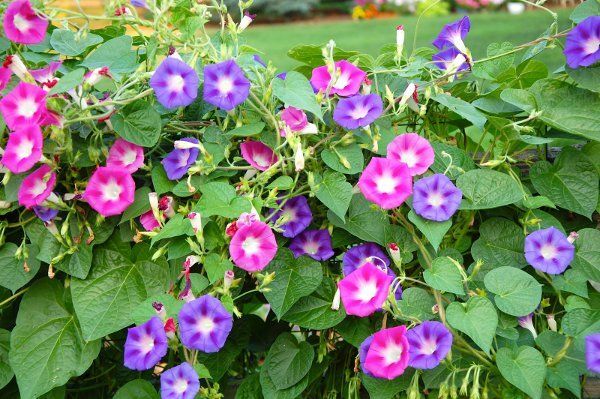
At home, it is grown as a perennial plant. Liana blooms with blue flowers, reminiscent of gramophones, located evenly on a thin stem. For decorativeness tied to the support, it is best for this lattice.
- Install in a well-lit place.
- Watering regularly, without drying the soil, otherwise the plant may die.
- In winter, cool content is required.
- Propagate easily, seeds.
Campaigned
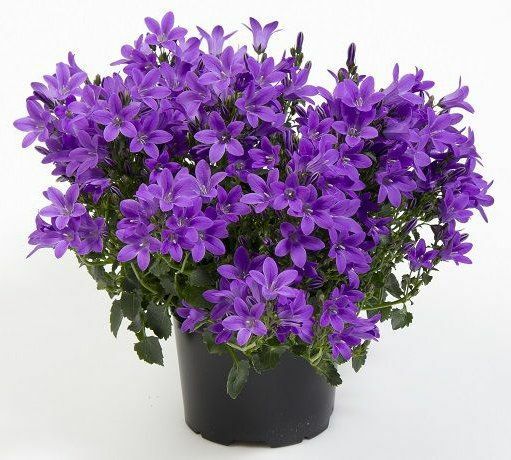
Another way it is called "bell" or "bride and groom".The most common are Campanula white and lilac shades. It looks great in suspended flowerpots or on supports. Beautifully combined two types of plants, white and blue, planted in one pot.
- They like fresh air, they grow well in the summer on balconies and verandas.
- At the end of autumn there comes a period of rest, watering is reduced, the lashes are cut off.
- It is recommended to update the plant every 2-3 years.
- Propagated by dividing the bush.
TUNBERGIA
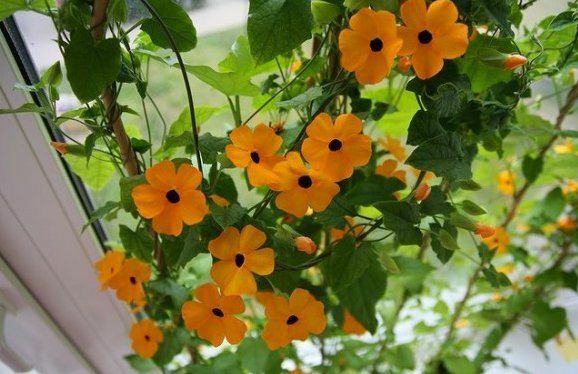
Rapidly growing liana with heart-shaped leaves. Flowers are original - yellow with a black core. It grows better on supports for vertical gardening. There are many varieties and varieties.
- Preferred room with bright lighting.
- To make the plant bloom more abundantly, the flowers are removed until the seeds are formed.
- You can propagate by cuttings and seeds.
Of course, the kinds of climbing houseplants are much larger. Among them there are rare and complex in care, so there is always the opportunity to replenish the collection and at the same time to expand and deepen knowledge of floriculture.
